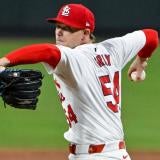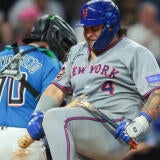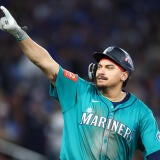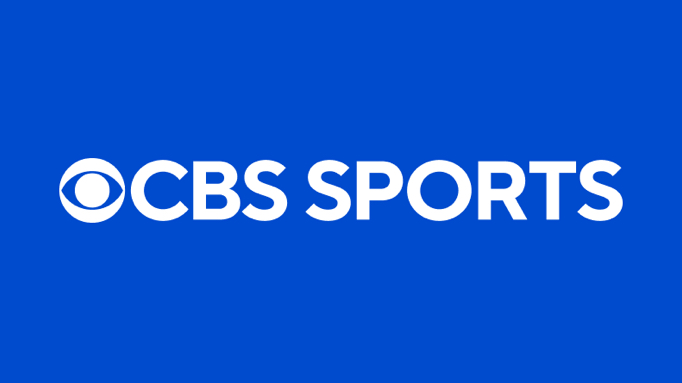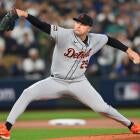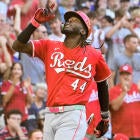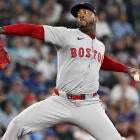The most interesting picks from our first 2026 mock draft: Early look at Tarik Skubal, Paul Skenes, more
It's never too early to get a jump on the competition for the 2026 season

If it's too early for you to start drafting for Fantasy Baseball, I understand. Spring Training isn't for another three months, the season doesn't start for almost five more months, and heck, even free agency hasn't really started yet. There's still so much about the 2026 season we don't know.
But that's not going to stop us sickos from drafting. Over at the National Fantasy Baseball Championships, drafts for 2026 have already started – real leagues for the 2026 season, with stakes and everything, are being drafted as we speak. I'm heading to BaseballHQ.com's First Pitch Arizona event this weekend – I'll be speaking on a panel about hitters, and Frank Stampfl and I will be recording a live episode of Fantasy Baseball Today! – and it's all about getting ready for the 2026 season. And that includes several drafts that will be happening live this weekend, as well.
To be clear, we're still talking about the 99.99th percentile of engaged Fantasy Baseball players who are actually putting their money down right now, so the sample sizes are small. When NFBC released their first run of early ADP, they did so with just 20 leagues' worth of data, which means one outlier result could really change a player's perceived value. These are interesting results from high-level players, but they should also be taken with a heavy dash of salt.
But there's also this: These drafts do have outsized influence! They help set the bar for where Fantasy analysts and players alike will expect players to be drafted. These valuations will shift over time, of course, but as anyone who has ever stumbled over their words when introducing themselves to someone knows: First impressions matter.
Over on the FBT side of things, we did our own first draft for 2026 last week. Ours was a mock draft, so we won't be playing the league out, which is fine – practice reps are important, and right now, when there isn't robust ADP or projections data and most people haven't finished their top-300-plus rankings lists yet, getting some of those practice reps in is important. Scott White has the full results of that mock draft for you here, and you can click here to see where everyone went in this 23-round Roto mock draft. In today's newsletter, I'm taking a look at some of the most interesting picks from this draft, with deeper thoughts on whether those players were good picks or bad picks and whether their price is likely to change from this point on.
Let's get to it:
The 15 most interesting picks from our first mock draft
1.10 - Tarik Skubal, SP, Tigers
We expect to see multiple first-round pitchers come off the board in 2026 drafts, and that's exactly what happened here. Skubal's ADP in those very early NFBC drafts is 8.3, so if anything, Scott White got a little discount here on Skubal, who is also my No. 1 SP. Since the start of 2024, Skubal leads all pitchers in strikeouts and WHIP, with only Paul Skenes ahead of him in ERA (in nearly 70 fewer innings). Skubal is on the trade market and could see a park downgrade in 2026 as a result, but seeing as he ranks third in FIP and third in xERA in that span as well, I don't care much about where he pitches. He was the No. 1 pitcher each of the past two seasons, and nothing about it feels flukey. I don't see much reason to overthink this.
2.2 - Paul Skenes, SP, Pirates
Garrett Crochet was the No. 2 pitcher off the board with the very next pick, which makes sense, because he went to me, and he's my No. 2 pitcher. And then I turned around in the second round and did the potentially unthinkable – I took a second starting pitcher with my second pick. I think all three of Skubal, Crochet, and Skenes should probably be first-round picks – I think there is a big gap between those three and the glob of pitchers in the No. 4 SP discussion – and I wanted to test out whether a roster with a Pocket Aces approach would be viable. I would have ground to make up with my hitters, and I decided I would mostly try to focus on relatively proven hitters for the next 10 rounds or so after taking my two aces. Here's how the squad came together:
Rnd/Pk Player
- 1/11 Garrett Crochet P • BOS
- 2/2 Paul Skenes P • PIT
- 3/11 Bryce Harper 1B • PHI
- 4/2 Manny Machado 3B • SD
- 5/11 Riley Greene OF • DET
- 6/2 William Contreras C • MIL
- 7/11 Bo Bichette SS • TOR
- 8/2 Nico Hoerner 2B, SS • CHC
- 9/11 Jhoan Duran P • PHI
- 10/2 Kyle Stowers OF • MIA
- 11/11 Agustin Ramirez C • MIA
- 12/2 Luke Keaschall 2B • MIN
- 13/11 Jakob Marsee OF • MIA
- 14/2 Mike Trout OF • LAA
- 15/11 Kris Bubic P • KC
- 16/2 Jacob Misiorowski P • MIL
- 17/11 Drew Rasmussen P • TB
- 18/2 Grayson Rodriguez P • BAL
- 19/11 Willson Contreras C,1B • STL
- 20/2 MacKenzie Gore P • WAS
- 21/11 Heliot Ramos OF • SF
- 22/2 Emilio Pagan P • CIN
- 23/11 Jordan Lawlar 2B,3B, SS • ARI
I think it's probably a viable strategy, though I would have felt a lot better about it if Yordan Alvarez had made it back to me in the third round – despite his injury history, his high upside in both batting average and HR makes him a potential first-rounder at a steep discount. I would feel better about this team with him as my first hitter instead of Harper, but I still think it can work.
2.6 - NIck Kurtz, 1B, Athletics
Kurtz's ADP in those early NFBC leagues is 15.3, so this also represents something of a discount. Especially since Kurtz went after Vladimir Guerrero, something I don't think we're actually going to see very often in 2026, especially once Guerrero's outrageous postseason run is further in the rearview mirror. I waffled on the Kurtz vs. Guerrero question before ultimately coming down on the side of Kurtz as the No. 1 first baseman, even if I think he's unlikely to be quite as good on a per-game basis as he was as a rookie. I think Kurtz belongs in the second half of the second round, with Guerrero more like a Round 2/3 turn pick, so Kurtz seems like a nice value there.
2.11 - Kyle Schwarber, DH, Phillies
This is right in line with where Schwarber has been going so far, and I'll be honest, it makes me a little queasy. Schwarber was the No. 5 hitter in 2025, but that was a career season as a 32-year-old, something I don't think we should necessarily expect from him again. He was the No. 17 hitter in 2024, No. 35 in 2023, and No. 18 in 2022, so it's not like this is a totally unreasonable price for Schwarber. But he's a free agent, which adds some uncertainty into his profile, though that could work both ways; while he could end up in a worse lineup and home park than he has in Philadelphia, it's also possible he'll sign somewhere that could play him more often in the outfield or at first base, giving the Util/DH-only Schwarber a more immediate path to eligibility elsewhere than he would have in Philadelphia. Schwarber is on the shortlist for best source of power in the game and has been a consistent bet for at least 200 combined RBI and runs, so he's a fine pick here. But taking someone this early whose batting average ceiling might be .250 means you really have to be conscious about how you approach that category moving forward. With your DH spot already filled, that's tough.
3.2 - Pete Crow-Armstrong, OF, Cubs
This might be a bit early. Might not be! Crow-Armstrong will be the player with perhaps the most wildly diverging opinions about his price in 2025, but it'll only take one person in every draft to push him close to the second round, and I wouldn't be surprised if that's where he ends up when all is said and done. The memory of his truly terrible second half is still fresh in folks' minds, but when people zoom out and remember he was still a top-20 player in Roto leagues despite the slump, I think his price will continue to rise. I expect Crow-Armstrong to be a top-30 pick for 2026, even if I won't be the one to draft him more often than not.
3.6 - Logan Gilbert, SP, Mariners
After our first three starters came off the board in the first 14 picks, there wasn't another one taken until the 30th pick. That was Gilbert, who I think is one of the strongest contenders for the No. 4 spot. Unsurprisingly, that started a run, with eight pitchers drafted between the sixth pick of the third round and the end of the fourth, and three more in the first six picks of the fifth. That represented most of my No. 4 Contenders list, though there was one notable exception – Jacob deGrom, who fell to the 11th pick in the sixth round and was probably the best single value among the high-end pitchers in this specific draft. Expect to see a lot of variance in the order that the No. 4 through No. 15 or so SP are drafted in, but they'll all likely go between the third and fifth rounds, in quick succession. If you're passing on the truly elite trio, be prepared to move quickly once that second group starts to move.
4.4 - Brice Turang, 2B, Brewers
I really can't figure out what to make of Turang's power breakout. He hit 18 homers in 2025, and the underlying data largely backs it up … but he also had 10 homers in August and no more than two in any other month. Months are arbitrary endpoints, full-season statistics are generally more predictive than partial-season statistics, and so on, and so forth. I get it, and I'm mostly taking Turang's full-season production at face value. I also think I'd feel better about that bet after the fifth round, but Scott White clearly disagrees, given this aggressive pick.
5.2 - Geraldo Perdomo, SS, Diamondbacks
Perdomo's price is going to be one of the most interesting questions of the 2026 offseason, and I think it's noteworthy that, despite outperforming someone like Crow-Armstrong in 2025, he's still likely to be significantly cheaper. In some ways, it actually feels like the fact that Perdomo didn't fade in the second half is somehow being held against him – as if we saw a best-case scenario from Perdomo, while Crow-Armstrong's second-half slump dragged him down from what should have been his best-case scenario. Early Steamer projections have Perdomo hitting .269/.364/.410 with 13 homers, 20 steals, 80 runs, and 58 RBI in 600 plate appearances, which feels especially light on the counting stat front with his spot at the top of the Diamondbacks lineup. But if that projection is right, it's going to be a bit light for this kind of price – Perdomo's 84.0 ADP over at NFBC is going to make more sense, and I suspect he'll settle closer to there (if not lower once the impact of projections is felt).
7.2 - George Springer, OF, Blue Jays
Speaking of those projections: While they are accounting for a step back from Springer, they still imply a decent bet at a seventh-round price – Steamer has him for a .260 average, 26 homers, 13 steals, 86 runs, and 72 RBI. Springer had arguably his best season as a hitter ever in 2025, and he only kept getting better as the season went on, a sign that pitchers didn't necessarily have an answer for what he was doing. And his underlying metrics were even a little better than what he managed on the surface. And his 109.9 ADP in those NFBC drafts makes Springer even more attractive. If last season's No. 8 overall hitter is actually going to have just a triple-digit ADP, that seems like a pretty inefficient market. I'd bet his price only rises from here.
8.3 - Mason Miller, RP, Padres
There's your first reliever off the board, and it comes significantly later than in those NFBC drafts. Which makes sense, actually – those drafts are for leagues that will actually be played out, and given the inherent uncertainty around relief pitcher roles at this time of year, the handful of truly elite relievers with guaranteed closer roles like Andres Munoz (45.8) and Edwin Diaz (46.7) will naturally find their prices inflated. In a pure mock draft, it doesn't make nearly as much sense to aggressively push those guys up when the reliever market will inevitably flatten once the musical chairs of the offseason stop moving.
What's interesting about our draft here is that it was Miller who came off the board first. In the NFBC data, he's the fourth reliever drafted on average, though I would imagine with a very wide range of outcomes from one draft to the next, given the uncertainty surrounding his role. He was a pure setup man to Robert Suarez after being traded to the Padres, but Suarez could become a free agent, putting Miller in a spot to be the closer for a contender in a great home park. Alternatively, Suarez could return and push Miller back to a setup role, and while he would still be worth drafting in that role, it would have to come at a big discount.
And then there's the big wild card: What if the Padres try to move Miller to the rotation? They had success making a move like that with Michael King a few years ago, and Miller has even better pure stuff. However, he has also shown basically no ability to stay healthy as a starter, so any role change would come with big upside, but also significant risk. Given all the moving parts here, I'm mostly fine with Miller's price here, even if I wouldn't necessarily take him as the first reliever off the board.
9.3 - Zack Wheeler, SP, Phillies
One of the true wild cards for 2026, the latest we heard is that the Phillies think there is a chance Wheeler could be ready for Opening Day after undergoing Thoracic Outlet surgery in September. Of course, Wheeler's Opening Day ability isn't the only, or even primary, question. The biggest question is how the soon-to-be 36-year-old will recover from an issue that led to scary blood clots this season. The data suggests thoracic outlet surgery isn't quite the death knell we sometimes think for pitchers, though it's also worth noting that the specific version Wheeler had, which was to relieve pressure on a vein, rather than a nerve, has a much smaller sample size of pitchers. If he had no health questions, Wheeler would have made it a Big Four at the top of the pitcher rankings, so I think dropping him right around the top-100 is probably the right call. And this is one where that early NFBC data is very much in line with our draft – he was the 99th pick in our draft and is 116.25 in those 20.
10.11 - Kyle Bradish, SP, Orioles
Coming back from Tommy John surgery, Bradish looked pretty fantastic in six late-season starts, putting up a 2.53 ERA with 47 strikeouts to 10 walks in 32 innings of work. His stuff still looks terrific, with multiple swing-and-miss fastballs and multiple swing-and-miss breaking balls. Bradish has thrown 71.1 innings since the start of the 2024 season with 100 strikeouts, a 2.65 ERA, and 2.48 FIP. He'll have some innings limitations in 2026 and likely won't throw much more than 160 innings, I would guess. But he might be a top-12 SP on a per-inning basis, so getting him outside of the top 100 feels like a really nice value.
11.11 - Agustin Ramirez, C, Marlins
It's going to be fascinating to see where the catcher values shake out in this newly flattened environment. In this draft, we had eight catchers go inside the first 10 rounds, which sounds about right. I suspect the order the non-Cal Raleigh catchers go off the board will change in basically every draft, depending on personal preference, team need, and more. Getting Ramirez as late as I did felt like a stroke of good luck, and one I can't count on every time – the latest he has gone in those 20 NFBC drafts is 110th, while he fell to 131st here. The out-of-position steals Ramirez provides as a catcher are super valuable and make him a potential standout, so I'd expect him to be one of the first five or six drafted in most leagues. The good news is, even if you wait until the double-digit rounds, in most drafts, that still means you should have at least one catcher with upside to choose from. You couldn't say that in years past.
12.3 Trevor Rogers, SP, Orioles
I don't really think anyone knows what to do with Rogers, who was so bad before 2025 that the Orioles kept him down for good until June, even though they were desperate for pitching and saw him toss six shutout innings against the Red Sox in a late May spot start. From his mid-June return through the end of the season, Rogers was arguably the best pitcher in baseball, and he finished with a 1.81 ERA and 0.90 WHIP with 103 strikeouts in 109.2 innings of work. His underlying numbers weren't quite that good, but his 3.34 xERA suggests he could still be very good even if there was some inevitable regression. Rogers posted the best walk rate of his career, his best strikeout rate since 2021, and some of the best quality of contact metrics we've ever seen from him. The merely good strikeout rate makes me skeptical, and I think there are enough interesting pitchers to target in the middle rounds – Kevin Gausman, Shane Bieber, Gavin Williams, Carlos Rodon, Nolan McLean, and Cameron Schlittler (among others) went in the rounds after Rogers. If that remains the case, I'll probably be passing on Rogers.
13.11 - Jakob Marsee, OF, Marlins
Marsee was basically on nobody's radar coming into the 2025 season. In BaseballProspectus' writeup of the Marlins farm system entering the season, he was outside of the top 20, under the "Persons of interest" heading; FanGraphs had him as the team's No. 27 prospect. Marsee was coming off a season where his batting average completely collapsed, and he just didn't show enough pop to overcome that. In 2025, however, he managed to hit .246 in Triple-A, which doesn't sound like much but is playable when he's lifting-and-pulling the ball consistently, drawing a walk in 16% of his trips to the plate, and stealing a ton of bases. He rode an almost certainly unsustainable .357 BABIP to a .292 average in the majors, and we shouldn't expect anything like that to repeat, despite his .283 xBA, Marsee's average quality of contact skills mean he'll probably have to sacrifice batting average to hit for much power. But even if he's more of a .260 hitter, Marsee's ability to draw a walk and do damage when he gets on the bases should play in Roto, and there's a chance he's basically Jarren Duran at a 10-round difference in price. There's also a pretty realistic chance he's just a flash in the pan you're dropping before the end of April. I was actually the one who drafted Marsee here, but I think moving forward, I'd prefer a bit more of a discount to take him.

